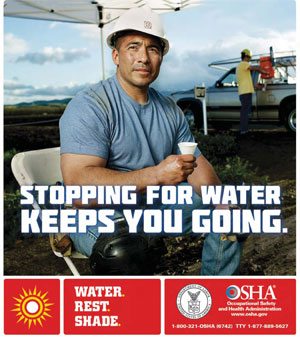As a supervisor or project manager, it’s critical for you to understand how your workers can protect themselves from the heat.
Your knowledge, ability to educate your employees and power to put heat-battling strategies in place are the first lines of defense against heat-related illnesses.
To help you protect your workers, the U.S. Occupational Safety and Health Administration has launched its fourth annual heat illness prevention campaign. OSHA’s campaign provides information regarding common heat illnesses and the best ways to prevent them from occurring.

OSHA provides materials to help employers train their workers.
Let Employees Get Used to the Heat
OSHA encourages managers to let workers get used to the heat. Acclimatization allows your employees’ bodies to build up a tolerance to the heat by slowly increasing the number of hours worked each day.
When the weather begins to turn hot, you should consider shortening work days or moving work shifts to earlier or later in the day to avoid the hottest time of day.
Measure the Risk Every Day
You should understand and check the heat index.
The heat index is the only measure that takes into account the temperature and humidity, and is a better tool for anticipating the level of risk the heat poses to workers. The higher the heat index, the higher employees’ risk of heat-related illnesses.
Create Shade and Require More Frequent Breaks
Workers are best protected from the heat by resting and cooling down in the shade. This may mean providing a tent or canopy at the job site.
If the site is inside a building or structure, you should consider fans to cool the environment. Also, make sure your employees take more frequent breaks throughout the work day.
Provide Plenty of Water
You should provide your workers with cool water and require water breaks every 15 minutes, according to OSHA. Employees should drink water to stay hydrated even if they don’t feel thirsty.
Check for the Signs
OSHA recommends routinely checking your employees for signs of heat-related illnesses while they are working. Warning signs of heat-related illnesses include fatigue, heavy sweating, rapid or weak pulse, nausea and fainting.
Provide Employee Training
You can be proactive about preventing heat-related illnesses by offering employee training. OSHA, in conjunction with other organizations, provides resources such as guides, DVDs and kits just for this purpose.
OSHA’s summer mantra is Water, Rest, Shade. You can keep those three words in mind when requiring workers to be outside in the hot weather.
Drinking plenty of water and getting some rest in the shade will help prevent your employees from getting sick on the job.